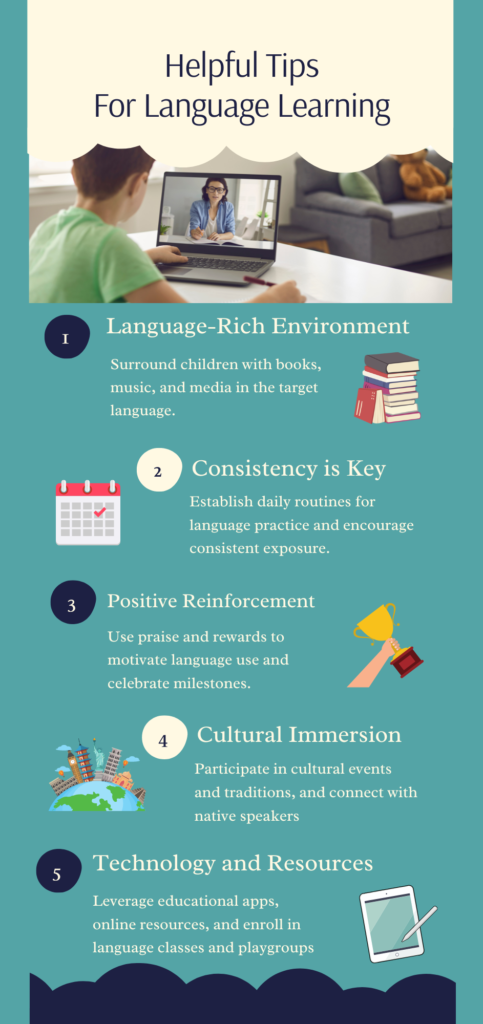Introduction
When it comes to language learning, timing can play a crucial role. Many parents wonder, “What is the best age to start teaching a second language?” In this article, we’ll explore the benefits of early language learning, discuss the concept of critical periods, and provide guidance on introducing a new language at different developmental stages. By understanding these factors, parents can effectively support their child’s language learning journey and set them on the path to bilingual proficiency.
The Benefits of Early Language Learning
Starting language learning at a young age offers numerous benefits. Young children have a natural ability to pick up languages more easily due to the plasticity of their brains. This plasticity allows them to mimic sounds, grasp grammar, and acquire vocabulary more quickly than older learners. Additionally, early exposure to a second language can lead to native-like pronunciation and a more intuitive understanding of language structures.
Research has shown that children who learn a second language at a young age tend to have better cognitive skills. They often outperform their monolingual peers in various cognitive tasks, such as problem-solving, multitasking, and creative thinking. Bilingual children also exhibit improved memory and attention control, as they constantly practice managing two languages.
Another significant advantage of early language learning is the positive impact on a child’s social and emotional development. Bilingual children often have better communication skills and can build relationships with a broader range of people. They are more empathetic and open-minded, as they are exposed to different cultures and perspectives. This cultural awareness fosters a sense of global citizenship and respect for diversity.
The Critical Period Hypothesis
The critical period hypothesis suggests that there is an optimal window for language acquisition, typically before puberty. During this time, the brain is more receptive to learning new languages. Understanding this concept can help parents determine the best age to start teaching a second language. While it’s possible to learn a language at any age, younger children often achieve higher levels of proficiency and more native-like accents.
Several studies support the critical period hypothesis, showing that children who start learning a second language before the age of seven are more likely to achieve native-like proficiency. This is because the brain’s language centers are more adaptable and efficient during early childhood. After puberty, these centers become less flexible, making language learning more challenging.
However, it’s important to note that language learning is not impossible after the critical period. Adolescents and adults can still achieve high levels of proficiency with dedication and the right resources. The critical period hypothesis simply highlights the advantages of starting language learning early and helps parents understand the best age to start teaching a second language.
For a deeper understanding of the critical period and its implications, you can read our article on Understanding the Critical Period of Language Acquisition: What Parents Need to Know.
Introducing a New Language at Different Ages
Understanding the developmental stages and the best ways to introduce a new language at each stage can help parents support their child’s language learning journey effectively.
- Infants and Toddlers (0-3 years): This is an ideal time to introduce a second language. Infants and toddlers are naturally curious and receptive to new sounds and patterns. Use simple words, songs, and games to make learning natural and enjoyable. Consistent exposure through bilingual caregivers, playgroups, and multimedia resources is beneficial. For example, singing lullabies or nursery rhymes in the target language can help infants and toddlers develop an ear for the language.
- Preschoolers (3-5 years): At this age, children are eager to learn and explore. Incorporate language learning into playtime, stories, and daily routines. Enroll them in language classes or playgroups to provide structured learning opportunities. Preschoolers can benefit from interactive activities, such as storytelling sessions, role-playing games, and educational apps. These activities make language learning fun and engaging, helping children build a positive association with the second language.
- School-Age Children (6-12 years): Older children can benefit from more formal language instruction. Encourage reading, writing, and speaking in the second language. Use educational apps, language classes, and cultural immersion experiences to enhance learning. School-age children can also participate in language exchange programs, where they interact with native speakers of the target language. This exposure to real-life conversations helps improve their language skills and confidence.
- Adolescents (13+ years): While the critical period may have passed, adolescents can still achieve high levels of proficiency. Focus on building vocabulary, grammar, and conversational skills. Encourage participation in language clubs, exchange programs, and advanced language courses. Adolescents can also benefit from immersion experiences, such as studying abroad or attending language camps. These experiences provide intensive language practice and cultural exposure, accelerating language learning.
Common Concerns and Misconceptions
Some parents worry that introducing a second language early might confuse their child or delay their native language development. However, research shows that bilingual children may initially mix languages, but this is a normal part of language development and typically resolves over time. Language mixing, also known as code-switching, is a sign that children are learning to navigate between two languages.
Bilingualism does not hinder native language development; in fact, it can enhance overall language skills. Children who learn a second language often have a better understanding of their native language, as they gain insights into grammar, vocabulary, and language structure. Bilingualism also promotes cognitive flexibility, allowing children to switch between languages and adapt to different linguistic contexts.
Another common misconception is that parents need to be fluent in the second language to teach it to their children. While fluency is beneficial, it is not necessary. Parents can support their child’s language learning by providing exposure to the target language through books, music, videos, and language classes. Engaging with native speakers, either in person or online, can also provide valuable language practice.
Understanding these misconceptions is important when considering the best age to start teaching a second language. Addressing these concerns can help parents feel more confident and informed in their decision to introduce a new language to their children at an early age.
Practical Tips for Parents

To maximize the benefits of early language learning, parents can follow these practical tips:
- Create a Language-Rich Environment: Surround your child with opportunities to hear and use the second language. This could include bilingual books, educational apps, music, and cartoons. For example, playing children’s songs in the target language during car rides or at home can make language exposure enjoyable and consistent.
- Consistent Practice: Consistency is key in language learning. Establish daily routines that incorporate language practice, such as reading bedtime stories or having themed days where only the second language is spoken. For instance, dedicating certain days of the week to speaking the target language can help reinforce learning and create a habit.
- Positive Reinforcement: Encourage and praise your child’s efforts to learn and use the second language. Make learning fun and rewarding. Celebrate milestones, such as learning new words or phrases, to boost your child’s confidence and motivation.
- Cultural Immersion: Expose your child to the culture associated with the language. This can include cultural festivals, cooking traditional foods, or connecting with native speakers. For example, attending cultural events or participating in language exchange programs can provide immersive experiences that enhance language learning.
- Language Classes and Playgroups: Enroll your child in language classes or playgroups where they can interact with other children learning the same language. Structured learning environments provide valuable instruction and social opportunities. Look for classes or playgroups that use interactive and engaging methods to keep children interested.
- Use Technology Wisely: Utilize language-learning apps, online resources, and educational videos that are designed for children. These tools often incorporate games, songs, and interactive activities that make learning enjoyable. Apps like Duolingo Kids, Gus on the Go, and Lingokids offer fun and effective language learning experiences.
- Incorporate Language into Daily Activities: Integrate language learning into everyday activities, such as cooking, shopping, and playing. For example, label household items in both languages, or practice vocabulary while grocery shopping by naming fruits and vegetables in the target language.
- Model Language Use: If possible, use the target language yourself, even if you are not fluent. Children learn by observing and imitating their parents. Simple phrases, greetings, and everyday expressions in the target language can provide valuable exposure.
Final Words
Starting language learning early can provide children with a strong foundation for bilingualism. The benefits of early exposure, coupled with the brain’s natural receptiveness, make the early years an ideal time to introduce a second language. By understanding the critical periods and developmental stages, parents can effectively support their child’s language learning journey and set them on the path to success.
Determining the best age to start teaching a second language is crucial for maximizing these benefits. With dedication and the right strategies, parents can help their children become proficient in a second language, opening up a world of opportunities and enriching their lives. The journey to bilingualism is a rewarding one, and the skills and experiences gained along the way will benefit children for a lifetime.




